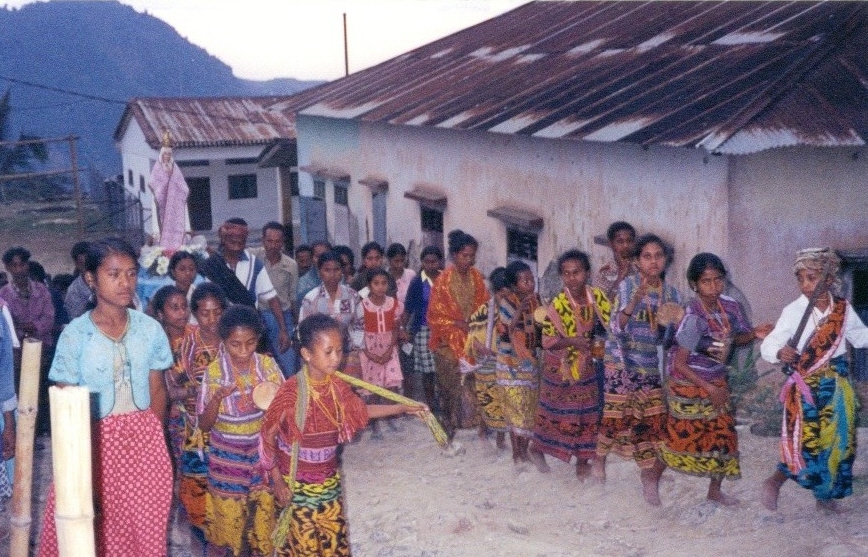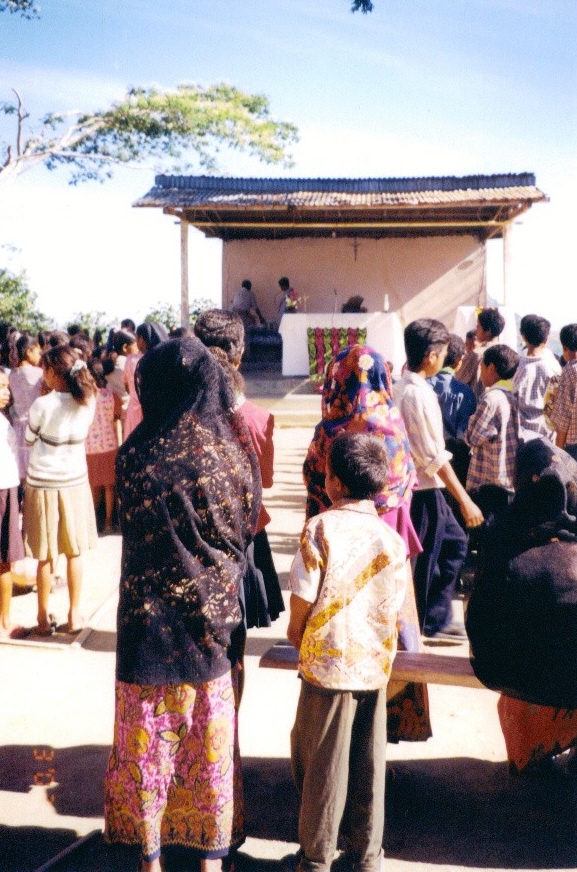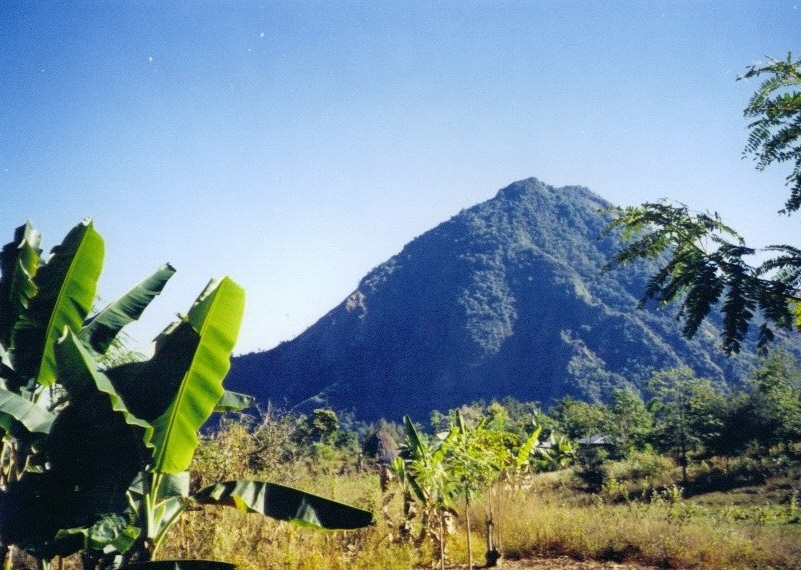
Religion: Catholicism[1]
and ancestral cults
The majority
of the population is Roman Catholic. According to the 2002 diocese statistics,
749,000 of the country’s total population of 792,000 are Roman Catholics.
Current statistics are not yet available about the other religious minorities
represented in East Timor, mainly Protestants, Muslims and Hindu-Buddhists.
Small concentrations of Protestants (around 20,000) have been reported in
Maliana, Aileu, and Baucau as well as in Dili. A smattering of Muslims and
Buddhists are also present in Dili. Current numbers are difficult to estimate
for these other religions, since most of their adherents were primarily
ethnically non-East Timorese who departed after the 1999 separation from
Indonesia. During the past three decades, the Catholic religion played an
important part in the lives of East Timorese. The Constitution of
this new nation, which was ratified on 22 March 2002, under Section 12
recognizes religious freedom and tolerance as long as religious activities are
in “due observance of the Constitution and the law.” Furthermore, paragraph 2 of
Section 12 declares, “The State shall promote the cooperation with the different
religious denominations that contribute to the well-being of the people of East
Timor”. In the literature, there has been virtually nothing reported about the
practices of Protestant, Muslim, and Hindu-Buddhist minorities in terms of the
uniquely East Timorese features of these religions. Protestant missionary groups
operate in small numbers in East Timor, however, exact figures are unavailable
and it is estimated that after independence the size of the congregation was
halved. In 2000 there were about 20,000 church members and only seven pastors to
serve them. With the exception of minor tensions in Baucau region between
Protestant missionaries and Catholics, the two Christian branches appear to
coexist peacefully. Minor isolated incidences of violence have been reported
against Muslim mosques in the capital city Dili and in Baucau. There have also
been tensions reported between Muslims of Arabic descent and Muslims of Malay
migrant descent. Unlike other World Religions, animism, mainly focusing on
ancestral beliefs has been documented in Portuguese colonial writings. Even
currently practiced Catholicism is a highly syncretized or indigenized
religion—indigenized through the lenses of traditional cosmologies and belief
systems of the East Timorese.
Catholicism,
introduced by the Portuguese during the 16th century, initially
spread to the more accessibly coastal regions while the mountainous interior
provided a geographical barrier (Felgas 1956; Matos 1974; Vasconcelos 1937).
After the 1975 Indonesian invasion, 72% of the population still remained animist
(www.timoraid.org;
Kohen 2001). While the Portuguese brought Catholicism to East Timor by the 16th
century, by the 1975 invasion of Indonesia, the majority (72%) of the population
remained animist. This period precipitated a steady stream of conversion to
Catholicism among the East Timorese. The importance of Catholicism grew during
the Indonesian occupation throughout East Timor in terms of a huge conversion
success. The Church was the main provider of protection, the vehicle of
non-violent protest and critique of brutalities, as well as the rallying point
for the freedom fighting movement (see for example, Carrey 1999; Gunn 2001;
Kohen 1998, 2001; Lenox 2000).
Roman
Catholicism was introduced to East Timor by the Portuguese by 1515. However, the
1556 arrival of the Dominican friar, António Taveira, marked officially the
commencement of a more widespread missionising effort. The East Timorese were
never forced to convert however if a local chief converted many of his people
would convert as well, therefore the Church’s effort concentrated on the north
and south coastal kingdoms during the late 16th century. By 1640
there were 10 missions and 22 churches on Timor. The next wave of expansion of
the faith began in 1697 with the return of Friar Manuel de Santo António to
Timor. By 1702 the Carmelite order was also present in East Timor. By 1747 there
were two seminaries established in Timor, in Oecussi and in Manatuto. The
missionising work of the Dominican friars, however, was hampered by a rather
tense relationship with the colonial administrative government on East Timor. In
1834 the Dominicans were expelled from East Timor and were replaced by the
Jesuit order. The Jesuits’ activities were not successful until the latter part
of the 19th century. In addition to Church-State relations,
missionising was also curtailed by the long history of East Timorese rebellions
against colonial exploitation. From the earliest times, however, the Church has
been an important supporter of the native populations against such
exploitations. Rebellions against the colonial power structure were often linked
to a great variety of revitalization movements throughout history. The Canossian
order of nuns returned to Timor in the early 1920s and the Salesian and Jesuit
orders returned after the Japanese occupation of WW II. After the Second
Vatican council the Portuguese language was replaced by the Tetum language
(1981) as the Catholic rites became vernacularized. While this contributed to
the Church’s headways in conversion rates, substantial success did not occur
until after the post-colonial Indonesian invasion in 1975 when the Catholic
Church ceased to a part of the Portuguese Catholic Church. The Catholic Church
became the protector of the masses providing physical refuge and moral support
against the brutality of the occupation, and thus incidentally becoming the
rallying point for resistance.
The major waves of concentrated efforts in spreading Catholicism in East Timor can be attributed to Friar António Taveira (1556), Bishop Manuel de Santo António (1697-1722), and Bishop António de Castro (1740s) and the bishop of Macau, Father José António Medeiros in 1875. Martinho da Costa Lopes, the apostolic administrator for East Timor and his successor, Bishop Carlos Ximenes Belo were post WW II native Church leaders with tremendous impact. Bishop Belo is best known for receiving the Nobel Peace Price (along with current foreign minister, Ramos Horta) in 1996. Under Lopes and Belo Catholicism firmly became established as the popular majority religion with an over 90% conversion rate. This success however can be as much attributed to their leadership qualities and their tireless efforts in championing the cause of East Timorese against the oppression and brutality of Indonesian occupation both locally and internationally, as to the refuge, protection and spiritual comfort they provided to the population. After Bishop Belo’s resignation the Apostolic Administrator of Dili was Bishop of Baucau, Basílio do Nascimento (since November 26, 2002). In March 2004 the Pope appointed Father Alberto Ricardo da Silva, the former Rector of the Seminary in Dili, as the new Bishop of Dili. Father Belo has served as parish priest in Mozambique since his resignation and has plans to return to East Timor in June 2005 and continue to serve as a priest in the poor countryside (National Catholic Reporter, February 4, 2005)

Procession of Mary in Atsabe (May 2002). There is a cult of
the Virgin Mary – the statue itself is considered luli (imbued with
spiritual potency)

Altar and worshippers during Sunday Mass which in Atsabe is always outdoors next to the chapel
Animistic
beliefs and practices have also been recorded produced by anthropologists in the
few existing ethnographies on East Timorese cultures (namely on the Viqueque
Tetun, the Marobo Kemak, and the Aileu Mambai). Currently on-going ethnographic
work on the Atsabe Kemak culture also uncovered the strong presence of animistic
beliefs and practices that are frequently syncretized with Catholicism. Colonial
history makes copious mention of animism in East Timor and a variety of
practices were attributed to this belief system, such as those beliefs
surrounding the concept of lulik (sacred places, objects, and persons).
Sacred places in local cosmology are linked to associations with founding
ancestors, the Creator God, and may include specific mountains, forests, rivers,
and even caves. Sacred objects tend to be ancestral heirlooms, especially
significant objects from oral history of interaction with Sky God, Mother Earth,
or battles with the Lord of the Sea. Even heads of enemies taken are sacred due
to the spiritual heat of the soul of the deceased; particularly the souls of
those who perished in war, accident, or other unnatural death. Ancestral focused
rituals are common and the most significant and elaborate for East Timorese are
the funerary rites. Funerary rites are generally expensive due to the number of
animals that need be sacrificed or given as part of the gift exchange cycle
demanded by obligations of kinship and social relations. Among the Kemak ethnic
group, the most elaborate part of the funerary rites are the secondary burials (leko-cicir
lia, Kemak language) where a number of deceased relatives bones are dug up,
cleaned, and reburied, while the soul of the deceased is guided in ritual chants
(nele, Kemak language) by the clan’s sacred man (gase ubu, Kemak
Language) to the village of the ancestors on Mount Ramelau. The ritual chants
can last over 14 hours as the soul is guided through the origin places of the
clan and the places of affinal groups, thus recounting the group’s oral history.
This ritual has high costs in animal sacrifices, especially that of water
buffalo. Other important East Timorese rituals focus on founding houses and
their sacred ancestral objects (lulik). Such sacred houses (uma lulik)
have an important role in maintaining traditional social structure and kinship
relations. Indeed, after independence a number of such founding houses (uma
lulik) that were destroyed in the 1999 post-election rampage were being
rebuilt with great fervor in spite of the economic expenses of large-scale
animal sacrifice. As a consequence of cultural diversity, there are at least
three different styles of sacred houses (uma lulik) present in East
Timor. The style of uma lulik that is a tall pile house is now also a
national emblem. Some agricultural rites that focus on the enhancement of
fertility of the fields are sometimes still performed but in an attenuated and
minimalist manner focusing on planting and harvest only, which local people tend
to attribute to a post-colonial attrition and as a consequence of Catholic
Church’s policies, attitudes, and anti-animistic actions. However, a late 1960s
ethnography on the Kemak suggests that the agricultural cycle rites were
performed in their entirety. Rituals tended to be categorized into two types
those concerned with life-generation and continuity, and those concerned with
death and discontinuity. The specific metaphors and idioms used vary from
culture group to culture group. The traditional ritual leaders sometimes
coincide with traditional political leaders but nowadays also with Catholic
catechists, former war leaders, and current administrative heads.
Atsabe Kemak
understanding and attitudes towards what is ‘sacred’ in Catholicism is informed
by and indigenized through local cultural beliefs about luli (Kemak).
While much of the literature has glossed lulik (Tetun) as magic, this is
a grievous misinterpretation and mistranslation. Potent spiritual force or power
associated with certain places, objects or persons is a more accurate gloss for
luli. Thus, Kemak Catholics view church buildings, cemeteries and
personages and objects associated with these places as sacred. Thus, clergy are
sacred due to the spiritual potency associated with them, much like the
traditional sacred men of the clan or village. The cross and statues of various
saints, Jesus, and especially of Mary, are also imbued with spiritual potency
and thus are luli. The Virgin Mary is a special focus of local Catholic
veneration. The Mary statue is not only venerated in a similar manner to
ancestral objects of luli but is given prominence in many village
churches in terms of placement, and regular flower and candle offerings. In most
rural areas, outside of settlements, one finds grottos carved out of hill or
mountain sides beside the road with a Mary statue that is believed to provide
protection (much the same way as certain ancestral spirits) for those who seek
it while travelling within the territorial boundaries of the village or
municipality.
Aspects of local Atsabe Kemak belief and ritual systems:
As mentioned above, one of the most important rituals for the indigenous
cultures concerns the complex cycle of funerary ceremonies (tau tana mate).
Funerary ceremonies are the most significant in the Kemak ritual system with
large-scale animal sacrifices, and are classified as black rituals, metama no.
The three main phases of funerary rites include huku bou, leko-cicir lia,
and koli nughu. Brigitte Renard-Clamagirand (1982:143-4), in her
ethnography, Marobo: Une Société Ema de Timor, refers to
this as taka no lia among the Marobo Kemak with several slight variations
in the ritual process. According to Elizabeth G. Traube (1986:200), (Cosmology
and Social Life: Ritual Exchange among the Mambai of East Timor),
the Mambai also classify funerals as ‘black rituals’. Secondary funerary
rituals are also present among the Mambai, (maet-keon) although there
does not seem to be an actual exhumation and reburial of the remains.
Amongst the Atsabe Kemak, huku
bou is the primary internment of the deceased that requires the sacrifice of
at least five buffaloes as well as complementary amounts of goats and pigs.
Leko-cicir lia is the secondary treatment rite that is the most economically
taxing ritual among all rituals of the Atsabe Kemak. Funerary practices are also
one of two types of ceremonies that focus on the maintenance of relations with
ancestors and on the continuous ritual restructuring of society and the renewal
of social relations between the living and the dead as well as between marriage
alliance partners.[2]
The ai mea wife-giver and wife-taker houses have a central role in
large-scale rituals, such as funerary ceremonies, and rituals cannot commence
until they all are present. Ai mea are the houses that are the original
and first wife-giving and wife-taking house to the house(s) that is holding the
funerary rites for their deceased member(s). The attendance and participation of
all the other bei-bei (regular) wife-giving and wife-taking houses is
also a strict social requirement. The sacrificial animals provided by the ai
mea are the animals whose blood is utilized in smearing ritual objects (such
as the grave in funerals). Furthermore, funerals, like all large-scale rituals,
must be attended by all the branch houses of the origin house sponsoring the
ceremonies (including all the wife-giving and wife-taking house of all the
branch houses) as well as those groups/houses that are in a ka’ara-aliri
(elder-younger) or sibling/friend-ally relationship to the hosting group.
Through the death rituals the most important alliances across the generations
are confirmed, through the fulfilment of duties via material contributions,
exchanges of goods, and the ‘blessing’ of all the wife-givers of the group whose
deceased are honored by such funerary ceremonies. Indeed the role of wife-givers
is part of a larger circulation of sacred power (luli) that enhances and
contributes to the continuity of life. This circulation also derives from the
ancestors and the deceased who will be transformed into ancestors through these
rituals. In funerary rituals the contribution of sacrificial animals, in terms
of amount and kind of animals, is directly related to the nature of social
relationships, and the order of sacrifice itself reflects the hierarchical order
of precedence in Atsabe social organization.
As pointed out above, an important characteristic of Atsabe Kemak death rituals is an elaborate secondary treatment of the dead (which in the past also required the taking of heads). This rite is held for a group of deceased relatives (regardless of rank or social status). These secondary rites are especially a grand-scale for local dignitaries, such as a group’s sacred men (individuals who are believed to possess concentrated and powerful luli, or spiritual potency), the heads of source houses and their family as well as rati, nai, dato (lesser chiefs and leaders of the domain), the traditional ritual leaders and koronel bote (the ruler of the kingdom). For such prominent figures of power and authority of the kingdom this leko-cicir lia ritual is performed for an individual deceased. The timing of the ceremony is usually before the planting season of dry fields (August-September), thus it is also linked with securing ancestral blessing for the success of the upcoming planting season. This secondary treatment not only concerns the physical remains, but more importantly the soul of the dead that are transformed into ancestors. In the local belief system, if the secondary rites have not yet been performed the soul of the deceased is said to stay near the house and village (asi naba coa pu). The longer the leko-cicir lia is delayed, it is believed that the soul of the deceased becomes ever lonelier for companionship, and thus calls the souls of the living to him. So a number of deaths close together in the same family are a sign that the leko must be performed and the souls must be transformed into ancestors and transferred to the ancestral villages. This ceremony, however, usually takes place several years after the first interment as it takes a long time to accumulate the economic means demanded by this rite (e.g. for animal sacrifice, cost of feast, grave construction, payment to the sacred man of the group, gase ubu, who performs the Toli rite, that transforms the soul of the deceased into an ancestor and guides him to the ancestral village). The closing of the Leko ceremony involves taking the cut-off genitals of all sacrificed animals (the means of creation and procreation) into the depth of the sacred forest, ai lara hui, and placing these out of sight at Bia Mata Ai Pun (the source of the spring and trees) and asking the ancestors to replenish (return) the animals that were sacrificed in the transferring of the souls of the deceased to the ancestors. This request is performed through a chant while handling the Loi Ana sacred beads. In secondary mortuary rites for a ruler, social relations and alliances in an entire kingdom (or now the current administrative units that were part of the former kingdom) become reconfirmed with the fulfilment of ritual obligations and participation.

Dar Lau Mountain—the mythical place of origins of the Atsabe Kemak people—the place where Earth and Sky were connected in primordial times
| << Previous |